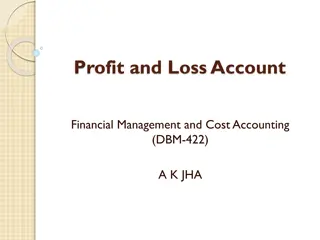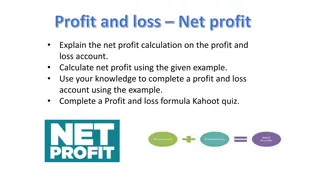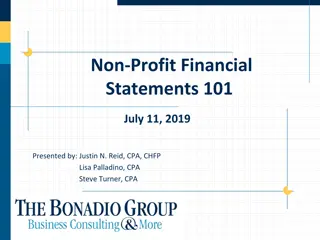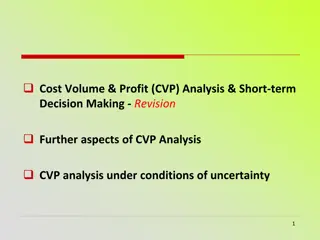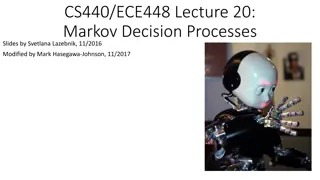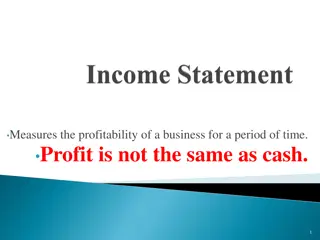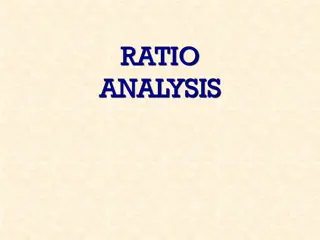Understanding Profit: The Entrepreneur's Reward
Profit is the reward for entrepreneurial functions and differs from returns on other factors due to its uncertain and residual nature. Various theories such as Frictional, Monopoly, Compensatory, and Innovation shed light on the complexities of profit generation in business.
Download Presentation

Please find below an Image/Link to download the presentation.
The content on the website is provided AS IS for your information and personal use only. It may not be sold, licensed, or shared on other websites without obtaining consent from the author. Download presentation by click this link. If you encounter any issues during the download, it is possible that the publisher has removed the file from their server.
E N D
Presentation Transcript
THEORY OF PROFIT PROF. SAPTARSHI CHAKRABORTY TARADEVI HARAKH CHAND KANKARIA JAIN COLLEGE COSSIPORE, KOLKATA -700002
NATURE OF PROFITS: Profit is a reward of the entrepreneur, rather of the entrepreneurial functions. Profit differs from the return on other factors in 3 important respects: Profit is a residual income not contractual or certain income & not contractual or certain income as in the case of other factors. There are much greater fluctuations in profits then in the rewards of the other factors. Profits may be negative, where as rent, wages & interest must always be positive.
NATURE OF PROFIT (CONTD..) 1. According to Prof. Marshall, Profit are the earning of management . 2. According to Prof. Benham, Profits have their origin in uncertainty . 3. According to Prof. Hawley, Profit is the reward of bearing risk .
GROSS PROFIT: Gross Profit is the profit , a company makes after deducting the costs associated with making and selling its goods , or the costs associated with providing its services. Gross Profit will appear on a company s income statement, and can be calculated with this following formula. Gross Profit = Revenue Cost of Goods Sold.
CONSTITUENTS OF GROSS PROFIT: Apart from pure profit, the following are the main constituents of Gross Profit: 1. Interest on entrepreneur s own capital. 2. Rent of land own by the entrepreneur. 3. Entrepreneur wages of management or superintendence. 4. Reward of the Entrepreneur as risk taker. 5. Gain as superior bargainer 6. Monopoly Gains 7. Conjunctural Gains.
NET PROFIT The profit of a company after operating expenses and all other charges including taxes, interest and depreciation have been deducted from total revenue. It is also called net earnings or net income . If expenses and charges exceed revenue, the company incurs a net loss.
PROFIT THEORIES: 1. Frictional Theory of Economic Profits 2. Monopoly Theory of Profits 3. Compensatory Theory of Economic Profits 4. Innovatiob Theory of Economic Profits
FRICTIONAL THEORY OF PROFITS It states that markets are sometimes in disequilibrium because of unanticipated changes in demand or cost conditions. Unanticipated shocks produce positive or negative economic profits for some times. Abnormal profits observed by unanticipated changes in demand or cost conditions.
MONOPOLY THEORY OF PROFITS Monopoly is a market structure in which there is only one producer/seller fo r commodity. This theory asserts that some firms are sheltered from competition by high barriers to entry. Firms with monopoly power restrict output and charge higher prices under perfect competition. This causes above-normal profits to be earned by the monopolistic firms.
COMPENSATORY THEORY OF ECONOMIC PROFITS Above-normal rates of return that reward efficiency. It states above-normal rates of return that reward firms for extraordinary success in meeting customer needs, maintaining efficient operations etc.
INNOVATION THEORY OF ECONOMIC PROFITS This theory was given by an American economist Joseph Schumpeter . According to Schumpeter, the principal function of the Entrepreneur is to make innovations and profits are a reward for successful innovations Innovation means think different from the rest. Above normal profits arise because of successful innovations introduced by the entrepreneurs. Above-normal profits that by successful invention or modernization
INNOVATIONS MAY BE OF TWO TYPES: Those which change the production function and reduce the cost of production i.e. Introduction of new machinery, improved production techniques or processes. Those innovations which stimulate the demnad for the commodity, i.e., which change the demand or utility function.
ACCOUNTING PROFIT It is the net income of the company earned during a particular accounting year. It reflects the profitability of the company. Accounting Profit = Total Revenue Total Explicit Cost
NORMAL PROFIT It is the minimum level of profit that is required for the survival of the company. Normal profit help to understand the future prospects of the company. Normal Profit = Total Revenue Total Cost = 0

 undefined
undefined




